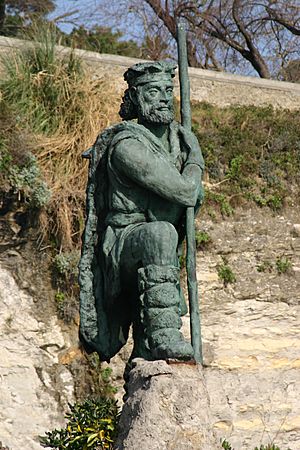Corocotta facts for kids
Corocotta is a legendary hero from Cantabria, a region in northern Spain. His story has been passed down through families for many generations. According to ancient Roman writings, Corocotta was a brave warrior or rebel who lived in Cantabria around 2,000 years ago. He was known for raiding Roman lands, causing a lot of trouble for them. The Roman Emperor Augustus was so annoyed that he offered a huge reward for Corocotta's capture. But here's the amazing part: Corocotta himself showed up to claim the reward! This act of daring really impressed Emperor Augustus.
Contents
The Cantabrian Hero: Corocotta's Story
Cantabrians remember Corocotta as a symbol of their people's strong spirit. They fought hard against the powerful Roman Empire during the Cantabrian Wars. Many brave warriors, both men and women, defended their homes and way of life. Corocotta was one of these heroes. Some people even spell his name Korokota, which is similar to the nearby Basque language.
Cantabrians believe Corocotta was a respected leader or warrior among his tribes. The Romans were so angry with him that they put an incredibly high price on his head. But Corocotta made an incredible choice. He decided to turn himself in to the Roman Emperor. His goal was to claim the huge reward money himself. He was even ready to give up his life for it.
A Sacrifice for His People
Cantabrians see Corocotta's decision as a great act of self-sacrifice. They believe he did this to prevent anyone from betraying him for the reward. Instead, Corocotta would take the vast sum of money. Or, if he was killed, his people would get it. This money would then be shared among the Cantabrian people. They had suffered greatly from years of war against the Romans.
This act of bravery would have amazed the Romans. The Cantabrians were known for their clever fighting methods. For example, they would sing victory songs even when they were being crucified by the Romans. They also used a special flag, the Cantabrian labarum, to signal army movements. The Romans later copied this smart tactic. Sometimes, the story ends with Emperor Augustus being so impressed by Corocotta's courage that he let him go. He even let Corocotta keep the money. However, this ending is not always clear in the stories.
The Roman Viewpoint: Augustus's Kindness
The Roman historian Cassius Dio wrote about Corocotta. He used the story to show how forgiving Emperor Augustus could be. Dio wrote that Augustus did not get angry easily. He even kept his promises to people who might not have deserved it.
Dio explained that Corocotta was a "robber" in Spain. Augustus was very angry at first. He offered a million sesterces (a type of Roman money) to anyone who could capture Corocotta alive. But then, Corocotta came to Augustus on his own. Augustus not only did not harm him, but he also gave him the reward money.
Historians believe Dio told this story for a reason. He wanted to show Augustus as a kind and confident leader. He wanted to compare Augustus's mercy with the harshness of other Roman emperors. This story shows Augustus's sense of humor and strong self-confidence.
See also
 In Spanish: Corocotta para niños
In Spanish: Corocotta para niños


